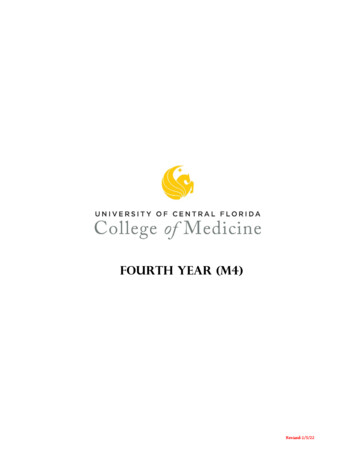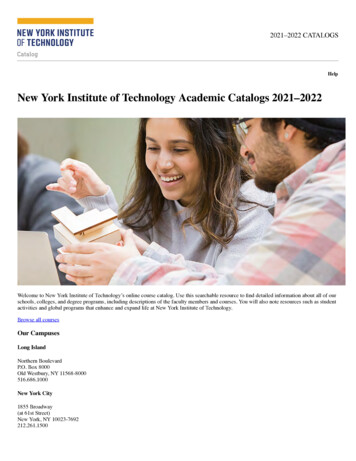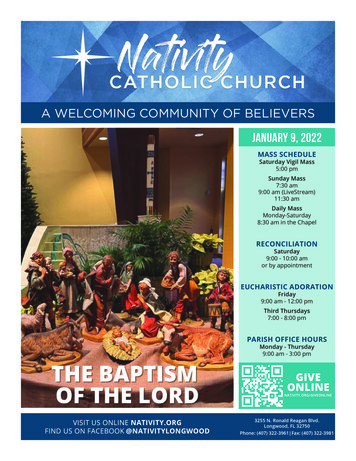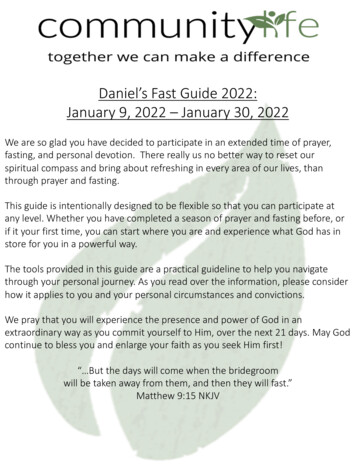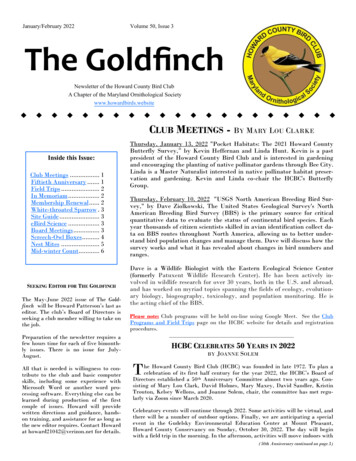
Transcription
January/February 2022Volume 50, Issue 3The GoldfinchNewsletter of the Howard County Bird ClubA Chapter of the Maryland Ornithological Societywww.howardbirds.websiteCLUB MEETINGS - BY MARY LOU CLARKEInside this Issue:Club Meetings . 1Fiftieth Anniversary . 1Field Trips . 2In Memoriam . 2Membership Renewal . 2White-throated Sparrow . 3Site Guide . 3eBird Science . 3Board Meetings . 3Screech-Owl Boxes . 4Nest Mites . 5Mid-winter Count. 6SEEKING EDITOR FOR THE GOLDFINCHThe May-June 2022 issue of The Goldfinch will be Howard Patterson’s last aseditor. The club’s Board of Directors isseeking a club member willing to take onthe job.Preparation of the newsletter requires afew hours time for each of five bimonthly issues. There is no issue for JulyAugust.All that is needed is willingness to contribute to the club and basic computerskills, including some experience withMicrosoft Word or another word processing software. Everything else can belearned during production of the firstcouple of issues. Howard will providewritten directions and guidance, handson training, and assistance for as long asthe new editor requires. Contact Howardat howard21042@verizon.net for details.Thursday, January 13, 2022 "Pocket Habitats: The 2021 Howard CountyButterfly Survey,” by Kevin Heffernan and Linda Hunt. Kevin is a pastpresident of the Howard County Bird Club and is interested in gardeningand encouraging the planting of native pollinator gardens through Bee City.Linda is a Master Naturalist interested in native pollinator habitat preservation and gardening. Kevin and Linda co-chair the HCBC's ButterflyGroup.Thursday, February 10, 2022 "USGS North American Breeding Bird Survey," by Dave Ziolkowski, The United States Geological Survey's NorthAmerican Breeding Bird Survey (BBS) is the primary source for criticalquantitative data to evaluate the status of continental bird species. Eachyear thousands of citizen scientists skilled in avian identification collect data on BBS routes throughout North America, allowing us to better understand bird population changes and manage them. Dave will discuss how thesurvey works and what it has revealed about changes in bird numbers andranges.Dave is a Wildlife Biologist with the Eastern Ecological Science Center(formerly Patuxent Wildlife Research Center). He has been actively involved in wildlife research for over 30 years, both in the U.S. and abroad,and has worked on myriad topics spanning the fields of ecology, evolutionary biology, biogeography, toxicology, and population monitoring. He isthe acting chief of the BBS.Please note: Club programs will be held on-line using Google Meet. See the ClubPrograms and Field Trips page on the HCBC website for details and registrationprocedures.HCBC CELEBRATES 50 YEARS IN 2022BY JOANNESOLEMThe Howard County Bird Club (HCBC) was founded in late 1972. To plan acelebration of its first half century for the year 2022, the HCBC’s Board ofDirectors established a 50th Anniversary Committee almost two years ago. Consisting of Mary Lou Clark, David Holmes, Mary Maxey, David Sandler, KristinTrouton, Kelsey Wellons, and Joanne Solem, chair, the committee has met regularly via Zoom since March 2020.Celebratory events will continue through 2022. Some activities will be virtual, andthere will be a number of outdoor options. Finally, we are anticipating a specialevent in the Gudelsky Environmental Education Center at Mount Pleasant,Howard County Conservancy on Sunday, October 30, 2022. The day will beginwith a field trip in the morning. In the afternoon, activities will move indoors with(50th Anniversary continued on page 3)
2WINTER FIELD TRIPSBY JOE HANFMANField trips are a great way to improve birding skills, explorenew places and meet other birders. Arrive at the meeting siteready to leave at the designated time with appropriate footwear and gear, Because of the ongoing Covid-19 pandemic,field trip leaders may limit the number of participants, requiremasks, or impose other conditions. For the latest information,please check with the leader or the Club Programs and FieldTrips page on the Howard County Bird Club website shortlybefore the date of the trip.START YOUR YEAR LISTJanuary 1, 2022, Saturday. Start at 8:00 a.m. (halfday). Meet at the Howard County Conservancy –Mount Pleasant Farm. Easy walking on woodlandtrails. Plan to bird several locations to find as manyspecies as possible The one day of the year when everybird is new! Facilities available at some locations.Leader: Kurt Schwarz, krschwa1@verizon.net, 410-461-1643BLACKWATER NATIONAL WILDLIFE REFUGEJanuary 8, Saturday, all day trip. Plan to stop at theChoptank River Bridge for ducks and coffee. Bringlunch and drinks. Dress warmly. Entrance fee or DuckStamp required. Email the leader to reserve a spot andget details. Facilities at some spots.Leader: Kurt Schwarz, krschwa1@verizon.net, 410-461-1643MID-WINTER COUNTFebruary 5, Saturday. See page 6 for details.HOW TO FIND AN OWLFebruary 19, Saturday, 9:30 a.m. and 1:00 p.m., possibility of birding at dusk for owls and early woodcocksfor those in the afternoon group. Learn how to findowls by habitat and signs. Jay is an expert at findingowls and will share his skills and knowledge as to howto find different species. Contact Jay to sign up so participants can be advised of weather-related changes andwhere to meet. Group size is limited and RSVP required. Our target species are Long-eared, NorthernSaw-whet, and other owls. No facilities.Leader: Jay Sheppard, jaymsheppard95@gmail.com(preferred), 301-725-5559IN MEMORIAMJANE GEUDER 1939-2021Long-time member Jane Geuder died November 28,2021, as a result of complications from Parkinson’sDisease. Because of Covid-19 there was no formalservice.Jane was best known to many members for her competence and enthusiasm in serving as program chairfor a quarter century. She and her husband, Ralph,were ardent hawk enthusiasts and were instrumentalin searching for a county hawkwatch site.For those wishing to remember Jane with a donation,consider the Parkinson’s Foundation of the NationalCapital Area (PFNCA), 3570 Olney Laytonsville Rd#490, Olney, MD 20830.A longer tribute can be found on the In Memoriamwebpage: In Memoriam Howard County Bird Club(howardbirds.website) .MEMBERSHIP RENEWALIf you have not yet renewed your membership for 2021-22,go to the HCBC website: https://www.howardbirds.website/and click on “Join Us’ at the top of the home page.Northern Saw-Whet OwlWOODCOCKSThe date will be mid to late February and announcedby Newsgram, email, or on the club’s website.Leader: Mary Lou Clark, doctorfx 99@yahoo.com Reservations required Fee for this trip Great for beginning birders Wheelchair AccessiblePhoto by Kevin Heffernanfrom a 2015 “How to Find an Owl” trip.
3(50thAnniversary continued from page 1)displays, prizes, and a program. Save that date!Responses to a questionnaire indicated members wanted acommemorative tee-shirt. A design contest, limited to members, was held in the fall of 2021. Sue Probst submitted thewinning design (by coincidence she had also designed the 25 thanniversary shirt). All the submissions were excellent; in fact,the committee was so impressed with one by Pam Perna thatit, too, will be used during the year. A 50th Anniversary pageon the website will appear on January 1, 2022, and Pam’sdesign will be the header on that page. Our warmest congratulations to both of these talented artists!White-throated Sparrow UpdateClub member Lynn Gregg photographed a nearly all-whitesparrow in an Ellicott City neighborhood on 19 February2021. A photo was included in the May-June 2021 issue ofThe Goldfinch, identifying the bird as a leucistic WhiteThroated Sparrow. We got the species correct, but not thespecific genetic abnormality.New material will constantly be added to the 50 th Anniversary page on the HCBC website. A November 2021 NEWSGRAM described a major project requesting memories fromclub members in either written or oral form. We look forwardto receiving many. Each will be posted on the web page inthe course of the year.The committee has been working with Field Trip Chair JoeHanfman planning a variety of trips, both in-county and out.This will likely be an opportunity to revive some trips thathave not been offered for years.In keeping with the pandemic’s necessity for minimal socialcontact, members will soon be able to accept the 50 th Anniversary Challenge requiring completion of a series of activities designed for all skill levels to be completed at your ownpace. Do join the fun.Be a part of this year-long celebration as individually andtogether we remember the achievements of the past 50 years,enjoy the present activities, and anticipate the next half century.Site GuideIncluded with this issue is the site guide for WildeLake. Guides to other birding spots are available onthe club’s website.Anyone is welcome to contribute articles or ideas which youthink will be of interest to other birders. Copy may be sentto:Howard Patterson4209 Hermitage DriveEllicott City, MD 21042-6235howard21042@verizon.netThe Goldfinch, newsletter of the Howard County Bird Club,is published five times per year. Copy deadline for theMarch/April 2022 issue is January 25, 2022.Howard Patterson, EditorJoanne Solem, ProofreaderW. Scott Young and Lynn published an article in the Fall2021 Issue of Maryland Birdlife, “A White-Throated Sparrow, Zonotrichia albicollis, with Probable Progressive Graying,” that describes several types of genetic coloration disorders and explains how the most likely disorder was identified.Maryland Birdlife is sent to all MOS members.Program Chair Mary Lou Clark is planning some special programs. For now, they will continue to be conducted virtually,but we hope that in-person meetings will be possible beforethe celebration ends.eBird Status and Trends - eBird ScienceIf you have not done so, take time to look at the eBird Science section. The November 2021 update includes severalnew and improved features that provide detailed insightsinto the abundance and distribution of more than 1,000 species. A summary of the updates can be found here.One feature, Abundance Animations, (examples can be seenin the link) is an animated display of species abundancethroughout the calendar year. This provides much more information than is displayed in a field guide.BOARD OF DIRECTORS MEETINGSThe January 27 and February 24 board meetings will beheld by teleconference or videoconference. If you have inputor questions, please send an email to Mary Maxey at maxeymom11998@gmail.com .
4EASTERN SCREECH-OWL BOXESBYWARD EBERTOur first Eastern Screech-Owl box was erected as an EagleScout project by Owen Deitz, his father, and Jay Sheppardon 27 March 2004, during the 2002-2006 Breeding Bird Atlasperiod. The box was provided free of charge, but I made adonation to the project via Jay Sheppard. Jay selected asmall Tulip Poplar and sawed off the top about 15 feet offthe ground to keep squirrels from jumping to it from othertrees.At Jay's suggestion I wrapped the tree with a band of aluminum flashing to keep squirrels from climbing the tree. Thatdidn't work, so I consulted Jay and added a second band tomake it about 18 inches high. That didn't work either and Iwound up adding a cone of flashing at the top of the twowraps. That worked. Jay had seen the wrap alone succeed,but I suspect the small diameter of this tree made the additional cone necessary.By mid-June, Great Crested Flycatchers were seen investigating the box and young subsequently fledged circa 20 July2004.On 19 December 2004 a rufous phase Eastern Screech-Owlwas seen in the box and appeared daily through the end ofthe year and then at least every other day in early January2005, last seen on the 19th. There was a sighting on 18 February and on 4 March that appeared to be a different individual. There were no further sightings until 28 and 29 November 2005, none the rest of the year.The first successful nesting was in 2006, the last year of theatlas period. First seen was a rufous or intermediate phaseowl in the box on the 2nd of April, and daily that week, more-or-less daily thereafter for a while and sporadically until mid-May when sightings picked up at dusk with earlier huntingforays. There was one occasion, 23 April, when one owl spentthe day perched in a low bush near the house. My notes indicate the young appeared to have fledged on 5/31 or 6/1.was no safe way to repair the box and eventually the tree fellover.We had no box for many years until I built and erected thenew one on 26 September 2015. This one was designed toidentical dimensions but made of outdoor-tolerant hardwoods (mahogany and redwood). It is mounted on a hingeon a pivoting post that allows easy lowering and raising forcleaning and repair. I located it closer to the house and inview of many windows. It was occupied by flying squirrelsmostly until autumn 2020.The owl history for this new box started on 2 November2020, with an owl appearing to roost in the box, followed bya pair nesting in the spring of 2021, and young (at least two)fledging around the middle of May 2021. The pair was firstseen in the box together on 12 February 2021. On 26 February I watched one owl head-butt the other owl out of theopening so it could perch there. The first owl perched in anearby holly tree. The first sighting of a nestling was on 12May, and two were seen together on 14 May. Young were lastseen on 16 May and no owls were seen thereafter in the firsthalf of 2021.Flying squirrels were seen in the box on a few occasions inthe summer.Since then an owl first appeared on 3 November this fall(2021) and has been seen daily to date (12/9/2021) usually atdawn and dusk, occasionally sunning itself during theday. It has usually perched in the opening but, on one occasion a few days ago, it appeared to be sleeping prone with thetip of its beak over the lip of the opening and its back visible. This owl has the same coloration as the two last winterand I cannot tell them apart.The next sighting was 7 October 2006. It was 29 Octoberwhen I first remarked in my records of the sighting of a grayphase owl. Sightings were frequent through to 4 March of2007, but none thereafter.The second nesting was in 2007, and several photographswere made including one showing a parent perched on a limblooking back at the box where two fledglings were in the boxopening. That year one of the young was found dead in aneighbor's yard shortly after fledging. The third and lastnesting in the original box was in 2009, with young first visible in the box on May 16th and last seen May 23rd althoughthey may have not fledged until the 25th.Sometime after that, a branch fell on the box, breaking off acorner. As the box was affixed to a now dead poplar thereEastern Screech-Owl in Box, November 2020
5HUMMINGBIRD NEST MITESBYRICHARD ORRThis Ruby-throated Hummingbird nest was closely watchedby Bonnie Ott and other members of the Howard CountyBird Club as the parents raised three healthy chicks. I askedBonnie if she would loan me the nest after the young had left.Hummingbird Nest MitesThe nest was surprisingly tiny (the measurement unit is inches in the above photo). It was hard to believe that it heldthree nestlings. The nest was made mostly out of lichens andsomething that to me resembled drier lint. Once I got thenest, I put it upside down in a Berlese Funnel and ran it for24 hours.At the end of the 24-hour run, I had collected 15 mites, anearly instar Psocoptera and an early instar larval Coleoptera(possible Carabidae). I was most interested in the mites, so Idiscarded the young beetle and barklouse.Of the 15 mites collected I believe that I had 5 differenttypes:Seven Mites of Type “1”: Mesostigmata --Macronyssidae –Ornithonyssus sylviarum (Northern fowl mite) – these werefeeding on the blood of the nestlings.Two Mites of Type “2”: Mesostigmata -- Laelapidae – Androlaelaps sp. – these were either feeding on the blood of thenestlings or were predatory on those mites that were feedingon the nestlings. These mites had three distinct ventralplates.One mite of Type “3”: Mesostigmata – unable to identify tofamily – single ventral plate. Likely a mite predator or birdparasite.by Richard OrrTwo mites of Type “4”: Trombidiformes – unable to identifyto family – mites with mouthparts deeply retracted and bodycovered with fan-like coverings. Judging from the needle-likemouthparts they were likely feeding on the nestlings.Three mites of Type “5”: Trombidiformes – unable to identify to family – mites with mouthparts deeply retracted andbody not covered with fan-like coverings. Judging from theneedle-like mouthparts they were likely feeding on the nestlings. Except for the presence or absence of the fan-like coverings, Type “4” and Type “5” mites are very similar andpossibly the same genus or species.I am a neophyte when it comes to mite identification andrealize my limitations. Any help with the identification ofthese mites is greatly appreciated. I have the mites on microscope slides and photographs at higher resolution upon request.The hummingbird nest was located in Ellicott City, HowardCounty, Maryland.Member Richard Orr is not only an entomologist by profession, but isalso a skilled birder and naturalist. His special interest is odonates;he annually compiles statewide dragonfly and damselfly sightings bycounty.
6HOWARD COUNTY BIRD CLUBChapter of the Maryland Ornithological SocietyP.O. Box 1323Columbia, MD 21044-1323January/February 2022 - Inside This IssueClub MeetingsField TripsMembership RenewalSite GuideBoard MeetingNest MitesFiftieth AnniversaryIn MemoriamWhite-throated SparroweBird ScienceScreech-Owl BoxesMid-winter CountTHIRTY-SEVENTH ANNUAL MID-WINTER COUNTBY JOE HANFMANJoin the Howard County Bird Club’s Thirty-seventh Annual Mid-winter Count on Saturday, February 5, 2022. Joe Hanfman(410-772-8424) / auk1844@gmail.com is the count coordinator. You may volunteer to participate by contacting one of the areacoordinators.Area 1Area 2Area 3Wes EarpBrian MoyerChuck Stirrat410-531-3197443-462-8234the comArea 4Area 5Area 6Mike McClureAllen LewisJohn is@gmail.comArea 7Kurt Schwarz410-461-1643krschwa1@verizon.netBeginning birders are always welcome, as are individuals whowish to count only for part of the day. If you wish to countonly at your feeder email Joe H. and request a feeder form.If a virtual tally is held, details will be provided later.If there is a question about the weather, we will try to makea decision the night before. Contact your area coordinator ifyou are unsure of the status of the count.
Jan 02, 2022 · The Goldfinch January/February 2022 Volume 50, Issue 3 Newsletter of the Howard County Bird Club A Chapter of the Maryland Ornithological Society www.howardbirds.website CLUB MEETINGS - BY MARY LOU CLARKE Thursday, January 13, 2022 "Pocket Habitats: The 2021
